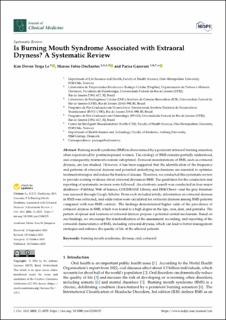Is Burning Mouth Syndrome Associated with Extraoral Dryness? A Systematic Review
Peer reviewed, Journal article
Published version
Permanent lenke
https://hdl.handle.net/11250/3096633Utgivelsesdato
2023Metadata
Vis full innførselSamlinger
Originalversjon
10.3390/jcm12206525Sammendrag
Burning mouth syndrome (BMS) is characterized by a persistent intraoral burning sensation,
often experienced by postmenopausal women. The etiology of BMS remains partially understood,
and consequently, treatments remain suboptimal. Extraoral manifestations of BMS, such as extraoral
dryness, are less studied. However, it has been suggested that the identification of the frequency
and patterns of extraoral dryness and potential underlying mechanisms are essential to optimize
treatment strategies and reduce the burden of disease. Therefore, we conducted this systematic review
to provide existing evidence about extraoral dryness in BMS. The guidelines for the conduction and
reporting of systematic reviews were followed. An electronic search was conducted in four major
databases—PubMed, Web of Science, COCHRANE Library, and EBSCOhost—and the grey literature
was assessed through Google Scholar. From each included article, information on extraoral dryness
in BMS was extracted, and odds ratios were calculated for extraoral dryness among BMS patients
compared with non-BMS controls. The findings demonstrated higher odds of the prevalence of
extraoral dryness in BMS, which was found to a high degree in the lips, eyes, skin, and genitalia. The
pattern of spread and locations of extraoral dryness propose a potential central mechanism. Based on
our findings, we encourage the standardization of the assessment, recording, and reporting of the
extraoral characteristics of BMS, including extraoral dryness, which can lead to better management
strategies and enhance the quality of life of the affected patients.

